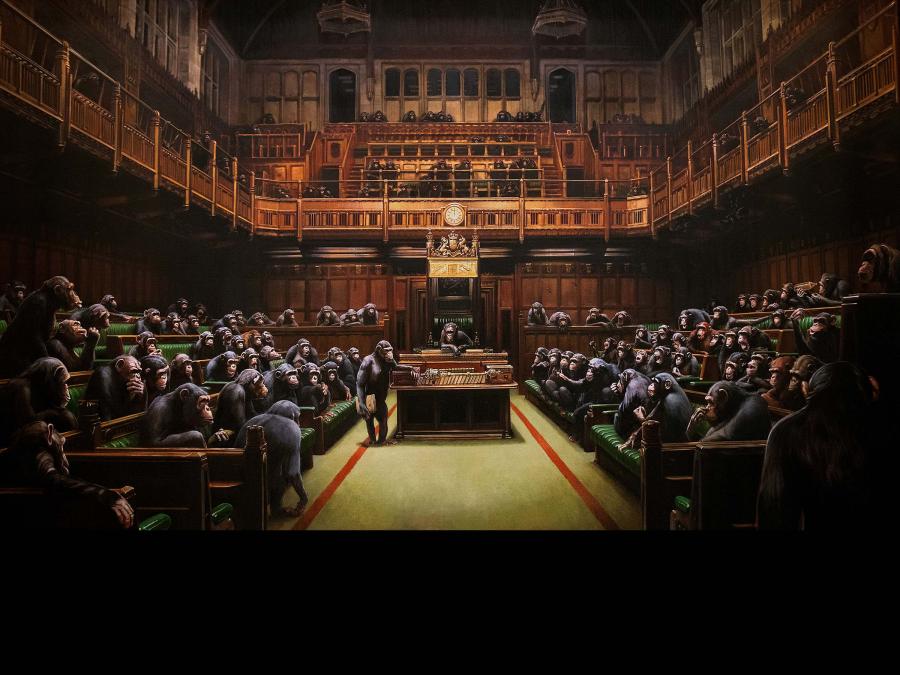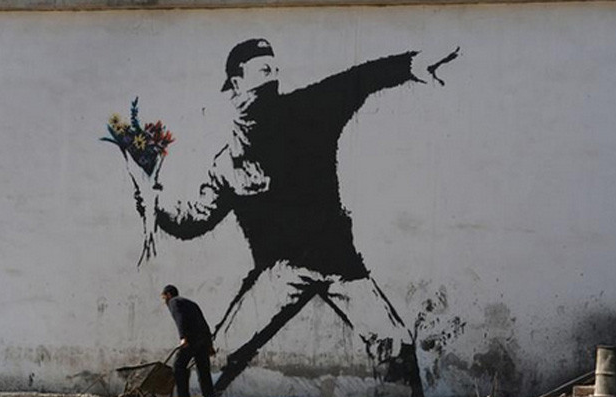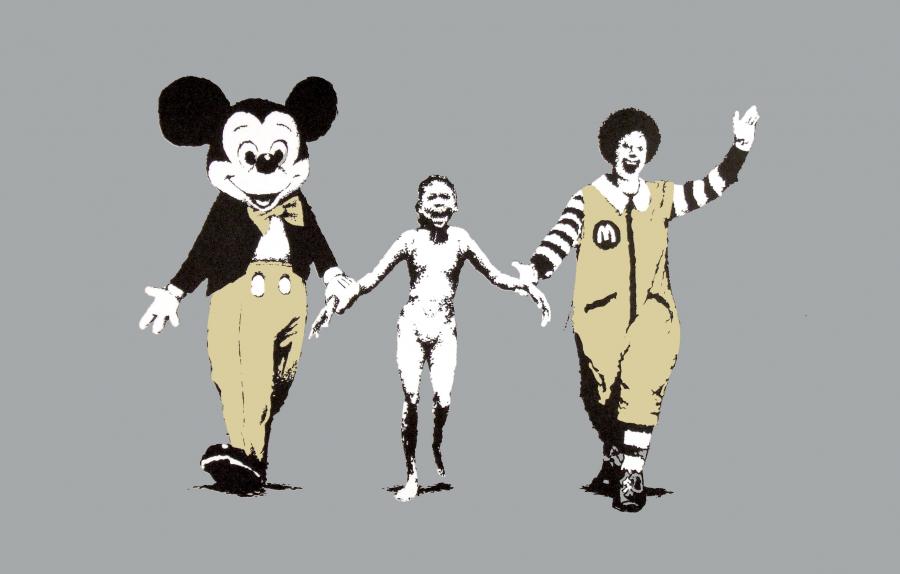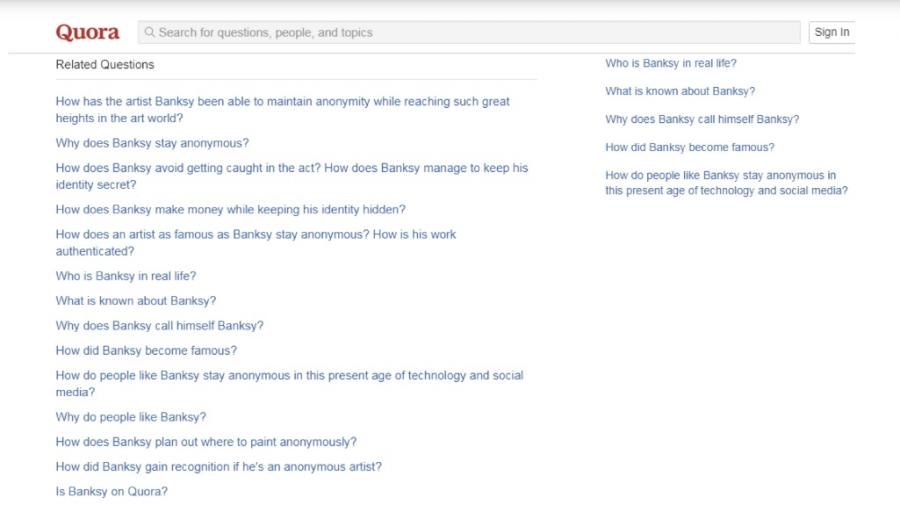
What is the phenomenon of Banksy?
Banksy is one of the most popular faces of street art with his unique and recognizable style. The (presumably) England-based artist is sometimes called a "vandal". Banksy's street art carries explicit political messages. His satirical graffiti, all made using the stencil technique, appears randomly in different parts of the world while their creator remains anonymous. While there is a lot of speculation and conspiracy theories surrounding his identity, this article will adopt the most common view of him being an individual, rather than a group of people, male, British, and having strong political views as an inspiration for his art.
Our perception of art, the way we define it, as well as art itself have been changing drastically with the rapid developments of digitalization and globalization. If we look deeper into history, “for many centuries, up until the mid nineteenth century, architecture, painting and sculpture were the three principal visual arts of Europe” (Walker, 2001). In the highly globalized and digitalized contemporary world, access to art and the growth of various kinds of art forms become more widespread at a faster rate. Increasingly, art and media are intertwined more than ever before. As a result, today's popular culture is not "dominated by the fine arts but by the mass media" as its central medium (Walker, 2001).
The case of Banksy exemplifies a great combination of art, intellectual thought, pop culture, and activism. This article aims to analyze the phenomenon of Banksy and his artworks, as well as how the artist strategically manages to trigger media activity and audience attention. Below, I will examine the art of Banksy as a popular and artistic object, what practices are involved in his works, the boundaries of popular culture and his art, and his relationship with his audience.
Who is Banksy?
Banksy is a world-famous street artist and activist. There is not much information available about him. Appearing like an urban hero with an active social stance, in his art Banksy criticizes “changes brought about by the industrial revolution, by the development of a capitalist economic system, and by the emergence of an urban, consumer society, [which] have irrevocably altered the social context in which fine arts operate” (Walker, 2001). Banksy's works became symbolical to the contemporary world in carrying anti-consumerism, anti-war, anti-fascism, and anti-imperialism messages as the creator combines street art, popular culture, and social activism. He does not only create outstanding art forms but is also known for attaching deeper political meaning to his graffiti for the audience to decode and reflect upon.
As an activist, Banksy uses art as a way to raise awareness and protest against current issues such as climate change, military conflicts, and poverty. “While hiding from the limelight, Banksy has made himself into one of the world's best-known living artists. His pieces have fetched millions of dollars at prestigious auction houses.” (Ellsworth-Jones, 2012). He has thus become one of the most influential and respected street artists, who voices statements on such important matters as politics, violence, capitalism, ethics, and culture as a form of activism.
Because of the artist's anonymity, the online dimension is the only accessible way for Banksy to communicate with his audience.
For the purposes of this article, some of the artist's works such as Napalm Girl and Girl with Balloon will be critically analyzed and the discussion will be informed by relevant academic literature. Digital ethnography will be adopted as a method to try to understand the way Banksy operates online as well as his fans' response on the matters of his identity and his art. Because of the artist's anonymity, the online dimension is the only accessible way for Banksy to communicate with his audience. On the other side of the spectrum, social media platforms are the best way for the artist's fans to communicate, research, and discuss his art as well as his identity.
The Phenomenon of Banksy’s works: art or strategic plan
The works of Banksy, as well as the activism behind them, carry multiple functions. Three primary practices present in his works make Banksy stand out from the crowd of other street artists and political activists: activism, political, and intellectual practices; popular culture practice; and artistic practice. In what follows, I elaborate on each of them in greater detail.

Art by Banksy
Banksy's activism, political, and intellectual practices
At first sight, it seems that the primary aim of Banksy’s works is to raise awareness of societal issues. His art urges audiences to think about current world problems, and the topics of life and death, war and peace, humanity, and activism. The popular motifs of his criticism are ecology, digitalization, capitalism, and world politics. Such works of his as Slave Labour, Kissing Coppers, Rage, the Flower Thrower, and Napalm Girl have become authoritative in the world of contemporary art. They carry powerful messages and aspire to a deeper commentary on themes such as war and peace in Rage, the Flower Thrower, or capitalism and conflict in Napalm Girl.

Figure 1: ‘Rage, the Flower Thrower’ (2005) by Banksy.
Although Banksy is mostly popular for his street art, he also creates statues, performances, and has built a hotel. Banksy’s graffiti became the face of an epoch, an act of criticism towards many of the world’s issues. Unlike many other kinds of street art, his works are most likely to retain and increase their value if we look at them from a long-term perspective. This is due to Banksy’s ability to capture topical issues in direct and creative ways, but also due to his performative artistic persona.
Popular culture practice
One more function of Banksy's art relates to popular culture. With his use of street art, he bridges the gap between high-flown art forms and deeper political messages, and broadcasts them directly to popular audiences. Banksy popularizes art amongst broad audiences by making it available on the streets and openly accessible public spaces. He captures his works with ease and irony, and they are relatively easy to understand and to interpret. In his own words: “They motivate the audiences to think about the current world issues, as well as about deeper meaning of being in a long-term perspective”. Banksy uses walls and spray paint, and the figures he illustrates are easily readable and accessible. This makes his art a welcome topic for both niche art critiques and a wider audience.
Banksy has developed a signature style that makes his works popular among the broad public. Marshall (2006) talks about the intense homogenization of musical products after the industrial revolution as one of the key transformations of art. If we extend this observation to visual art, we can observe that Banksy has a very recognizable style in this contemporary context. Even though his graffiti appear in different places, we could always recognize them due to his distinct style. His works might capture bits and pieces of a specific context of a certain area, however, they remain homogeneous and distinct.
Artistic practice
The artist's works entail a meta-discourse on art itself, especially the institutional perspective on fine art. Banksy's art is criticism and a sign of protest in and of itself. This may also explain why he chooses graffiti, a type of art in open public spaces. In this way, audiences do not need to purchase tickets as is needed for closed-off spaces like galleries and museums.
Even though the roles of both activism and popular culture are prevalent in Banksy's works, the artistic aspect is still predominant in adding value to his graffiti. The aesthetics of his works are appreciated worldwide. Banksy’s art is kept secure and recently got exhibited in galleries. Some of his art pieces are sold for over 1 million US dollars.
However, Banksy does not appreciate the monetization of his works. Last year, he set up the shredding of one of his murals, Girl with balloon, as a sign of a protest, right after it was sold at an auction. The whole action appeared to be a well-planned performance. The moment the auction alarm sounded, the painting started an automatic process of shredding itself with the help of a mechanism built into the frame. Banksy commented on his Instagram account that "[t]he urge to destroy is also a creative urge", quoting Picasso, which creates yet another link between mass and high culture. Still, the performance turned out to have the opposite effect on his work's monetary value. Art experts claim it could be worth even more after the damage.
The Napalm Girl example
In order to better illustrate the claims made about the multiple functions of Banksy's work, I will examine the artist’s graffiti Napalm Girl (2004-5) as an example. Napalm Girl is a work that exemplifies all the aspects of Banksy's work discussed above. It shows us three figures, two of which are the family-friendly faces of American capitalism. Mickey Mouse and Ronald McDonald signify the well-being of American children and what the government does to stir their attention away from the horrors of war.

Figure 2: “Napalm Girl” (2004-5) by Banksy.
In the middle, we see Kim Phuc, a girl also known as the "Napalm Girl". Originally, her picture was captured by a photographer during the Vietnam War and represents the fear and the dangers of that period. Such a combination of characters makes a political statement about the values central to capitalism and the influence of the U.S. on the world on multiple levels, namely as a political authority and an imperialist force, but also as a producer of dominant cultural narratives. It also deals with the spectacle effect and the high commodification value of the image.
The combination is quite controversial, and it significantly adds to the work's artistic value. Both the manner and the composition of this art piece align with high artistic standards. In fact, this graffiti has become one of the artist's most famous works.
The usage of popular symbols, such as Mickey and McDonald brings this work closer to mass culture. The two characters have a dominant media presence and are highly recognizable. Even though Napalm Girl is highly appreciated in high art circles, it was still drawn on a wall with simple spray paint, which makes it more readable for popular audiences. Thereby, we can see Banksy's key practices merging in one work: political and intellectual practice, artistic practice, and popular culture practice.
Banksy uses his graffiti as a tool to build a bridge between popular culture, arts, and activism. He connects street art and high-flown spaces and audiences that attend art galleries and auctions. This practice is strengthened by his political message. At the same time, besides creating a well-appreciated and highly-valued art piece, he does not hesitate to use popular characters such as Mickey Mouse and Ronald McDonald in controversial ways, decontextualizing them. These simple, well-known figures serve to make the political statement more pronounced and accessible for different types of audiences.
The identity of Banksy
Banksy has chosen to remain anonymous and this fact plays a significant role in his media persona. His hidden identity has become a part of his artistic performance. It has some cultural importance attached to it, it makes him into a modern-day Robin Hood, and it plays a huge role in his connection with his audience. Because the hidden identity of Banksy became an important part of his performances, this part of the article will deal with the cultural importance of Banksy’s hidden identity, its media coverage and profit, Banksy's pop star practices and his connection with fans.
All four parts are necessary to examine for a thorough discussion of Banksy's works. His mysterious identity has become more than just his persona. It is a statement and a performance, which has evolved into a significant part of his art.
Cultural importance of Banksy’s hidden identity
To this day, graffiti is considered vandalism. Many street artists hide behind pseudonyms and this practice is an important part of graffiti culture. Banksy prefers staying anonymous due to his provocative works which often carry a political statement. “He claims he needs his anonymity to protect himself from the forces of law and order” (Ellsworth-Jones, 2012). Many believe that it is questionable whether his influential status in the art world would save him from the legal consequences of his actions.
However, it might be the case that Banksy's authority would save him from facing vandalism charges. There is a big chance that the unwillingness of being exposed and the "legal" motivation is a part of a well-thought-through identity. In other words, it can be a smart ploy to draw more attention and respect from the fans, as well as recognition within street culture.

Figure 3: Response to the discussions around the identity of Banksy “Banksy’s real name is”.
Media coverage and profit
The mystery around his identity adds to the thrill of fans and media, who try to uncover his true personality. Banksy is a case of an anonymous celebrity, which challenges the very essense of being a celebrity. At the moment, due to his anonymity, he appears as a hero, as a lone genius, who defends the world by imbuing his works with controversial political messages and motivating audiences to think critically about them. “We all enjoy the mystery of the man who has somehow managed to get himself described as ‘Robin Hood’ even though he is hardly robbing rich to feed poor” (Ellsworth-Jones, 2012). He is well-appreciated not only because his works carry powerful messages and artistic value, but because he seems to be uninterested in getting personal fame in return. He makes his anonymous identity into artistic practice, which adds to his image as a whole. When we talk about Banksy and his works, we talk about the rebel who appears to be using his mysterious personality as a brand.
The secret identity also contributes to the artist's popularity and increases the value of his works in the market. One more ingredient that adds to Banksy's mystery is the fact that his art unpredictably appears in different places. He is untrackable and no one can predict when and where his next work will appear. Such a system creates a kind of quest in which the public has to discover the new item wherever and whenever it appears.
When a new Banksy work does appear, local and international media alike explode with stories about the artist, trying to find the aim behind where the work was placed, its cultural value, and its hidden symbolism. Thereby the artist and his works receive lots of promotion, which ultimately leads to his popularity and recognition. His identity, even though it seems rebellious and mysteriously hidden, is carefully planned and quite beneficial for the artist. As we can see in the screenshot from quora.com below, people are particularly interested in all kinds of details about his persona. Questions like "Who is Banksy in real life?" and "What is known about Banksy?" intrigue the audience.

Figure 4: Questions (mostly related to the identity) about Banksy on Quora.com.
Pop star practices and connection with fans
Not only are his works in the center of public attention, but the artist himself is quite a sensation and a matter of general interest. Media buzz around Banksy and the mass reproduction of his works as souvenirs on such websites as ebay.com, aliexpress.com, etc., contribute to creating a pop celebrity status for the artist.
Meanwhile, the artist's "true fans" stress the need to protect his identity and respect his will to remain anonymous. Indeed, there seems to be some pop star quality around Banksy's work and image in relation to his fans. “Through the use of the technologies of reproduction and distribution, the possibility of a fundamentally different relationship of the audience to the pleasures of popular music and their stars became manifest”, says Marshall (2016) of pop stars and their connection to fans. In Banksy's parallel case, fans build communities of appreciation, document, and even physically protect some of his works. On one occasion, Banksy’s fans tried to save a piece of a wall with his graffiti on it to prevent any damage to the work (Gregory, 2009).
Another parallel with contemporary pop celebrities (Click et al., 2013) can be established for Banksy's case. Banksy uses the internet as the main medium for communicating directly with his fans. Click and colleagues (2013) stress "the importance of interactive media in the creation of an expectation of communication between fans and celebrities that feels both real and two-way”. To this end, Banksy has an Instagram account followed by 5,6 million people (as of 05.04.2019) as well as an official website. He uses the former for keeping his fans updated about the new projects he is working on. Through digital media, Banksy affirms a strong connection with his fans. Despite this connection being mediated, "fans increasingly experience it as real and authentic, reinforcing their feelings of truly “knowing” [the celebrity]”. (Click, et al., 2013).

Figure 5: Official Instagram of Banksy.
Banksy's Instagram account hosts numerous pictures of his graffiti, mostly without any description. In this way, he has turned his Instagram into a fast medium through which he can inform his followers about his new works in an immediate, straightforward fashion. His bio announces “not on facebook, not on twitter”, which adds more explicit value to his Instagram as the sole means of communication with his fans. Due to his anonymity, such an attitude only warms up the interest of his audience. Although the artist does not engage with his fans in the comment section, his posts create the feeling of addressivity and presence and encourage fans to react to them.
Banksy also has an official website, banksy.co.uk, where he collects photo documentation of all of his art performances, such as his graffiti and sculptures but also his hotel. Even though the website has a "Q+A" section, it does not grant any potential for direct two-way communication with his fans. The available option is to write an email: “Send all questions, complaints and threats to faq@banksy.co.uk.”, which is not nearly as fast and straightforward as communicating through a public Instagram account.
The observations above point to the importance of social media for Banksy's artistic practice. The artist only makes the audience more curious by never posting pictures of himself, and only publishing photos of his works in a random manner, without mentioning locations or including descriptions of his art. This contributes to his popularity and celebrity status, while it also popularizes the messages of his works contributing to his activist action. This aligns with a general tendency of contemporary celebrities to "utilise social media to mobilise audiences towards philanthropic and activist cause” (Bennett, 2014). Choosing platforms where direct feedback is immediately available, and where audiences of billions are reached, is a strategic tool for engaging and stimulating the attention of the artist's admirers. Banksy's art is often controversial, which makes his posts controversial, too. This very much helps in triggering discussions in comment sections, especially when the artist adds his comment to describe the work, as then the author's interpretation enters the discussion. Finally, social media platforms are also helpful for fans, who find a way to address the artist and know where to look for "authentic" Banksy.
The phenomenon of Banksy: artistic, activist, political
In this article, we have taken a closer look at the art of Banksy, one of the most well-known street artists in the modern world. Evidently, the artistic and the political intertwine in the artist's work, which constitutes a form of activism. The mystery around his identity along with his limited but important interaction with fans through mainly his Instagram account also contribute to the effectiveness of his message and render him something of a pop celebrity. At the same time, his work is also appreciated as "high art".
All this renders Banksy as a phenomenal artist. The influence he has on contemporary culture is significant as everything he does is highly appreciated and hotly debated. This popularity is the result of hard work, careful planning around his art, and curated secrecy of his identity and social media appearance.
References:
Banksy, (n.d.). Retrieved from: banksy.co.uk on 04.04.2019.
Bennett, L. (2014). ‘If we stick together we can do anything’: Lady Gaga fandom, philanthropy and activism through social media. Celebrity Studies, 5(1-2), 138-152.
Click, M. A., Lee, H., & Willson Holladay, H. (2013). Making Monsters: Lady Gaga, Fan Identification, and Social Media. Popular Music and Society, 36(3), 360-379.
Ellsworth- Jones, W. (2012). Banksy: The man behind the wall. New York: St. Martin's Press
Gregory, M. (2009). Banksy fans move an entire wall - to save his work from, er, graffiti artists. Daily Mail.
Walker, J. A. (2001). Art in The Age of Mass Media. Pluto Press.
Marshall, P. D. (2006). The meanings of the popular music celebrity: The construction of distinctive authenticity. In P. D. Marshall (Ed.), The celebrity culture reader, (pp. 186-222). New York: Routledge.